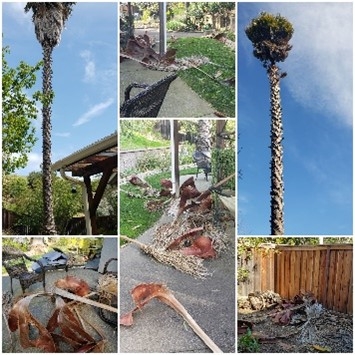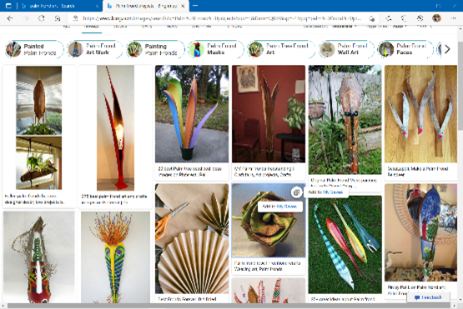- Author: Nancy Forrest
The weekend of Jan 21, 2022, was quite exciting with the football playoffs and winds gusts between 20 and 45 mph. miles per hour. Saturday, I woke up around 3 am to hear the winds in the background and the banging of branches against our patio cover. However, I did not realize the extent of the wind on my trees until I went out the next morning. My redwoods lost branches, so did my palm tree that is about 50 feet tall. As you can see from the pictures, it needed some trimming. Not anymore. Nature took its course and saved us quite a bit of money. However, the mess it left is another story.
What to do with disposing of palm fronds?[1] Well, artists have been creating art from all kinds of found objects like driftwood pieces, tree branches, seashells, stones, rocks, etc. so palm fronds are great sources of material for art projects. Checking out the internet and Pinterest there are thousands of projects. I decided to save a few fronds and complete a project or two of my own (in progress).
For any project, the basic steps are easy, clean with a wire brush and then wash with detergent. After it is dry use your imagination to create whatever, you can dream up. The fronds that I have work best to make masks, and unbelievably reindeer, because of their shapes. The leaves are great to use for a Tiki-looking backyard display.
In reviewing the different websites, I came across a section that made planters for succulents out of them. I decided since I had a lot of succulents it would make a great gift for someone. So, for a made one, you will need the following:
- Palm fronds- any shape you like
- sphagnum moss
- plastic chicken wire
- metal wire
- outdoor grade crafting paint
- polyurethane sealer-glossy
- twine
- copper or steel wool pot scrubber
- succulent cuttings
First, clean it. This is an untouched frond. Using a copper dish scrubber works best. Then paint it on all sides and let it dry (if you want it natural looking skip this and just varnish it). Seal it with glossy polyurethane varnish and let dry. Then make the container to hold the plants. Roll out the wire and cut it to the size of the frond. Fill wire with moss and roll up like a burrito. Fasten the ends with wire or twine to secure. Poke holes in the moss with a sharp pencil or screwdriver. Then arrange moss in a palm frond. Next, arrange the succulents by inserting them into the mossy bed. After inserting plants, build up the moss around the entry points.
Tip: when planning uses a variety of color that complements each other, use a variety of shapes vertical, horizontal, and spikes.






I would love to see someone do a tutorial on actual painting a scene on one.